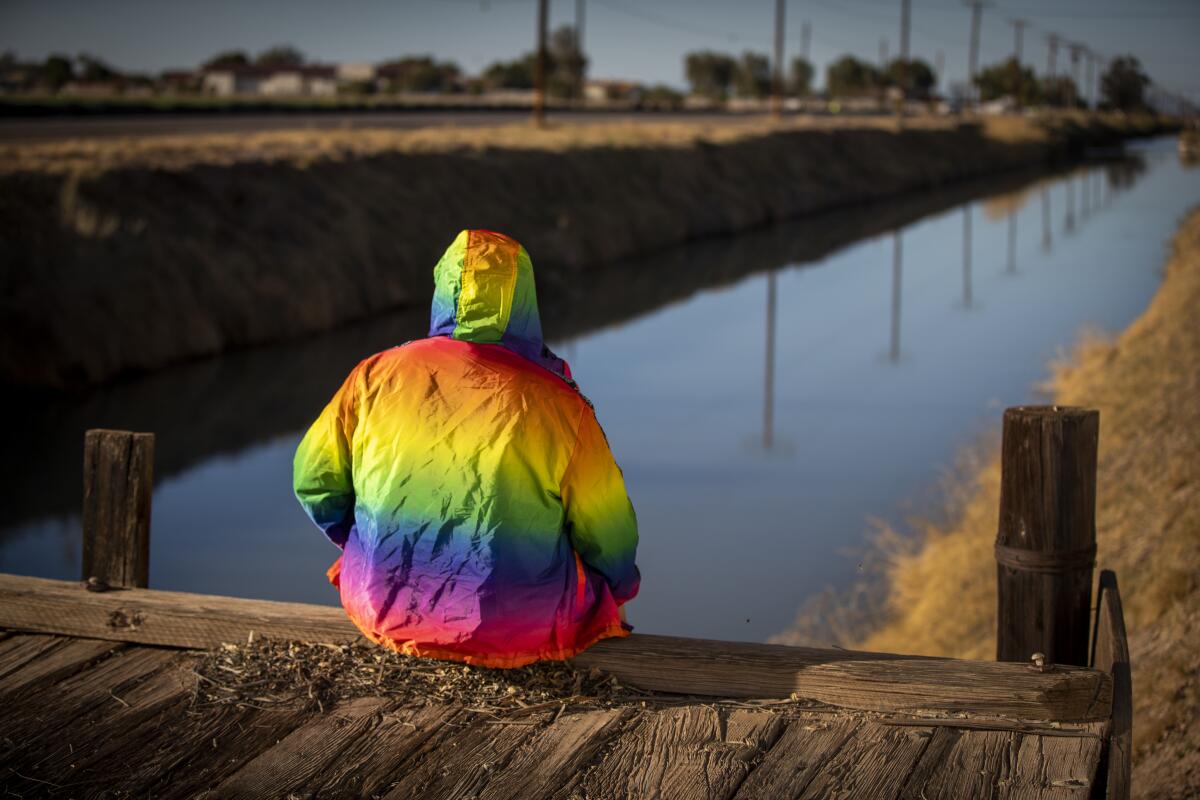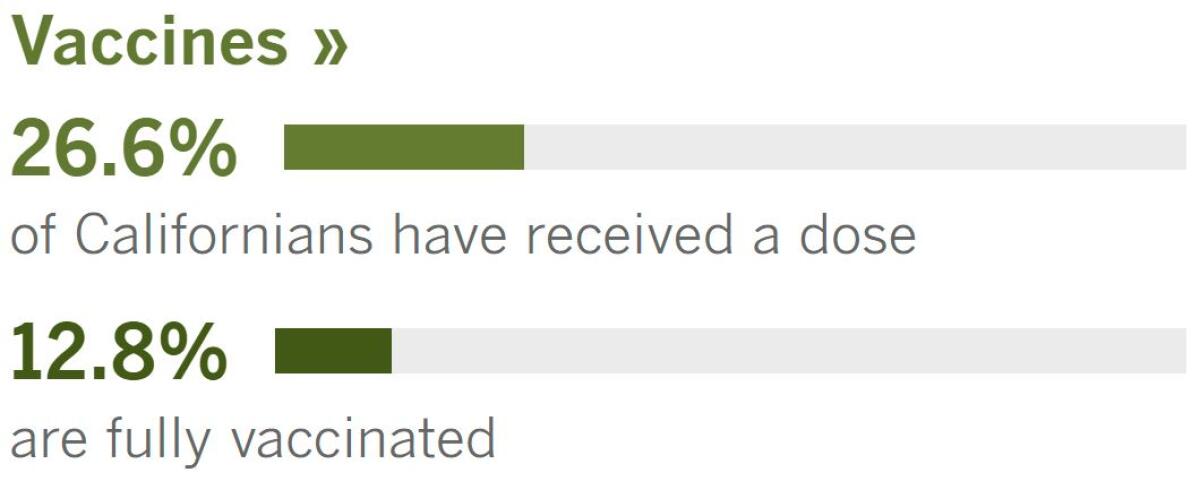Coronavirus Today: ‘Like going back into the closet’
- Share via
Good evening. I’m Deborah Netburn, and it’s Wednesday, March 24. Here’s what’s happening with the coronavirus in California and beyond.
Yesterday we celebrated. Today we cry.
My colleague and friend Laura Newberry brings us a heartbreaking story about the painful experiences of LGBTQ college students who, because of the pandemic, are once again forced to live with family members who do not know of or reject their queer and trans identities.
For many of these students, going away to college finally gave them a sense of freedom and independence and a feeling of belonging. Now, being back at home often leaves them feeling trapped in an environment that threatens to unravel their hard-won self-confidence, Newberry writes.
The result can be life-threatening.
When Enrique, a UC student in Southern California, first learned his campus was closing last year, he thought: “This will probably be over by May. I’ll be OK.”
But one month at home turned into two, then three. Then there was no end in sight.

By the fall, Enrique was struggling with substance abuse and suicidal thoughts. He’d felt depressed before, when he was coming to terms with his sexuality, but he had never wanted to harm himself.
He found himself sleeping away the hours he was not logged on to Zoom for classes. In retrospect, he attributes his depression to the shame he felt around his parents.
University of Missouri student Afua Owusu-Agyeman had a similar experience when her school shut down in March 2020 and she moved in with her parents.
Owusu-Agyeman’s accepting friends at college made her feel like her “soul was being cradled,” but back home the silence around her queerness intensified as the pandemic wore on.
She tried to sign up for university counseling, but increased demand meant waiting months for an appointment. She called a suicide hotline almost every night.
“I don’t think it can be underestimated how much that this can crush your spirit,” Owusu-Agyeman said, “being told every day that it is not OK to be yourself.”
Surveys suggest these young people are not alone. Since last March, Trans Lifeline, a crisis hotline for transgender people, has recorded an 18% increase in calls in which people talk about being rejected by their families. The number of people contacting the Trevor Project, a suicide hotline for LGBTQ youth, doubled at times in 2020.
Of course, before the coronavirus took hold, LGBTQ college students spent school breaks with families who do not affirm their sexual or gender identity. But the stresses of the pandemic — the isolation and duration — have been different, counselors said.
“When I would work with folks going home for spring or summer break, we would create safety plans,” said Tiffany O’Shaughnessy, a counseling professor at San Francisco State. “If their family was attacking them verbally, if they were feeling overwhelmed, they knew they could go to this friend’s house, this library, this coffee shop.”
Not this time.
Reading this story, I kept thinking: There are so many reasons why we need this pandemic to end.
By the numbers
California cases, deaths and vaccinations as of 5:37 p.m. Wednesday:

Track California’s coronavirus spread and vaccination efforts — including the latest numbers and how they break down — with our graphics.

Across California
If you’ve noticed your friends in other states are having an easier time getting vaccinated than Californians, you are not wrong. California is lagging behind some other states in expanding vaccine eligibility.
Alaska, West Virginia and Mississippi are vaccinating everyone ages 16 and up. Georgia, Arizona and Texas will follow suit this month. Everyone 50 or older is now eligible in Florida and New York, and Indiana and Ohio are vaccinating residents in their 40s.
To add insult to injury, whether or not you are eligible to receive a vaccine no longer depends solely on what state you live in. Here in California, eligibility now differs county to county.
In parts of the Bay Area, anyone who is 50 or older can get the COVID-19 vaccine right away. In San Diego, health officials are vaccinating anyone with asthma or Type 1 diabetes. And in San Francisco, the shot is available to anyone who is HIV-positive or is considered obese.
L.A. County, which has maintained some of the most limiting rules for eligibility, continues to follow the state’s guidance, the Public Health Department said Tuesday.
Why the discrepancy? Some counties expanded access because they had seen dwindling interest in vaccines and needed to boost demand, others because they’d received additional doses through the state or pharmacies, my colleagues explain. Still other counties, including Los Angeles, are struggling to secure enough doses to meet their existing demand.
Counties that have made the shots more widely available are sparking joy among locals — and fueling feelings of frustration and envy among people who live in counties that are sticking with stricter rules.
But it won’t be much longer until there’s plenty of vaccine for anyone who wants it. Barbara Ferrer, head of L.A. County’s Public Health Department, said Tuesday that she hopes the county will open vaccinations to everyone before May 1, the date targeted by Gov. Gavin Newsom.
But much depends on supply. In the early days of open eligibility, the county should focus on vaccinating residents in neighborhoods hit hardest by COVID-19, she said.
And finally, L.A. Times travel writer Chris Reynolds offers up a preview of life in the orange tier with a story about what tourists can expect when visiting San Francisco, which moved out of the red tier Tuesday.
“A visitor now can expect busier restaurants, revived museums, lower room rates and fewer amenities at hotels, a new Ferris wheel in Golden Gate Park, and a higher fisherman-to-tourist ratio than Fisherman’s Wharf has seen in generations,” he writes.
San Francisco still has a ways to go. There are no working cable cars, Coit Tower is locked, there are fewer fancy food purveyors in the Ferry Building, and there’s almost always an awkward pause at the entrance to restaurants as diners return. Indoor dining may be allowed, but so far, most residents have been hesitant to eat inside despite the city’s notorious damp and chilly weather.
And finally, to those readers who noticed the reopening map in yesterday’s edition was incorrect, and that California should look far less purple: Thank you! Last night’s newsletter erroneously included an outdated map that reflected counties’ tier assignments from March 9. Here’s the correct map:


See the latest on California’s coronavirus closures and reopenings, and the metrics that inform them, with our tracker.
Consider subscribing to the Los Angeles Times
Your support helps us deliver the news that matters most. Become a subscriber.
Around the nation and the world
I truly hate to be the bearer of bad news, but I’m a journalist and we’re in a pandemic, so here we go.
A new coronavirus variant was recently found in India that has two mutations that affect the spike protein that the virus uses to fasten itself to cells.
Dr. Rakesh Mishra, the director of the Center for Cellular and Molecular Biology in Hyderabad, said these genetic tweaks could be of concern since they might help the virus spread more easily and escape the immune system‘s defenses. Still, he cautioned against linking it to a recent surge in the country .
Cases in India had been plummeting since September, and life was returning to normal. But then they began rising last month. In a recent 24-hour period more than 47,000 new infections were detected and 275 deaths were reported — the highest one-day death toll in more than four months.
Health officials admitted they were worried about upcoming festivals, many of which mark the advent of the spring.
Moving west, the European Union is moving toward stricter export controls to ensure it has more doses of COVID-19 vaccine as another coronavirus wave sweeps across the continent.
Specifically, the EU’s executive body said Wednesday that it has a plan ready to guarantee that more vaccines produced in the bloc are available for its own citizens before they can be exported.
EU nations feel particularly put out by Britain, which has received some 10 million doses from EU plants while, they say, nothing has flowed in from British production sites. The EU now insists on reciprocity as it sees vaccination rates in Britain racing upward while its own vaccine rollout proceeds at a crawl.
British Prime Minister Boris Johnson has sought to ease tensions, speaking by phone in the last few days to European leaders, including European Commission President Ursula von der Leyen and French President Emmanuel Macron. “We’re all fighting the same pandemic across the whole of the European continent,” Johnson said.
And as a parting gift, I give you this cathartic story on the United States’ inconsistent, incomprehensible rules on who is eligible to get a vaccine and who isn’t. If you think there is no rhyme or reason at all to the eligibility rules across states, know that many experts agree with you.
“There is no logical rationale for the system we have,” said Graham Allison, a professor of government at Harvard University. “We have a crazy quilt system.”
Your questions answered
Today’s question comes from readers who want to know: If I’ve been fully vaccinated, is it safe for me to take public transportation?
If you have received all the required doses of a COVID-19 vaccine, you should feel comfortable using public transportation, said Dr. Armand Dorian, interim chief executive and chief medical officer of USC Verdugo Hills Hospital.
The three COVID-19 vaccines that are currently authorized for use by the U.S. Food and Drug Administration are all safe and effective in preventing serious complications from COVID-19, Dorian said.
However, the vaccines have not yet been shown to prevent coronavirus transmission. Studies on this are underway, but in the meantime, there is still a possibility that someone who is vaccinated may be infected with the virus and can spread it to other people in their household or social circle.
Therefore, if you are planning to take public transportation, it is important to continue following the public health recommendations of wearing a face covering, sanitizing your hands and staying home if you do have symptoms — whether or not you have received a vaccine, Dorian said.
We want to hear from you. Email us your coronavirus questions, and we’ll do our best to answer them. Wondering if your question’s already been answered? Check out our archive here.
Resources
Need a vaccine? Keep in mind that supplies are limited, and getting one can be a challenge. Sign up for email updates, check your eligibility and, if you’re eligible, make an appointment where you live: City of Los Angeles | Los Angeles County | Kern County | Orange County | Riverside County | San Bernardino County | San Diego County | San Luis Obispo County | Santa Barbara County | Ventura County
Need more vaccine help? Talk to your healthcare provider. Call the state’s COVID-19 hotline at (833) 422-4255. And consult our county-by-county guides to getting vaccinated.
Practice social distancing using these tips, and wear a mask or two.
Watch for symptoms such as fever, cough, shortness of breath, chills, shaking with chills, muscle pain, headache, sore throat and loss of taste or smell. Here’s what to look for and when.
Need to get tested? Here’s where you can in L.A. County and around California.
Americans are hurting in many ways. We have advice for helping kids cope, resources for people experiencing domestic abuse and a newsletter to help you make ends meet.
We’ve answered hundreds of readers’ questions. Explore them in our archive here.
For our most up-to-date coverage, visit our homepage and our Health section, get our breaking news alerts, and follow us on Twitter and Instagram.




